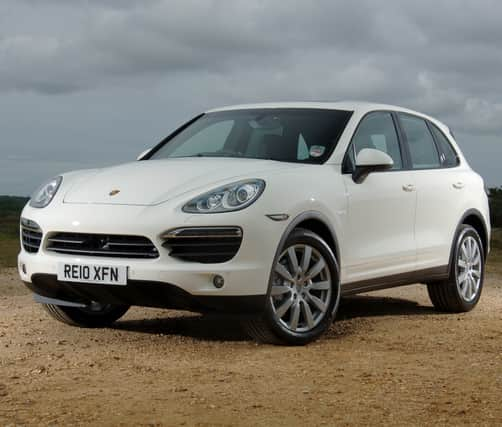Porsche gets a buzz from hybrid power: the Cayenne S Hybrid


Tentatively prod the accelerator the Stuttgart-built SUV and it will waft forward in absolute silence.
It’s always been an unusual experience driving anything with that distinctive Porsche shield and anything other than a straight-six soundtrack, but this takes the biscuit...and Porsche is serious about hybrids.
Racing hybrids show Porsche's new spark
Advertisement
Hide AdAdvertisement
Hide AdLast year we got a tantalising glimpse of the electric revolution hitting Stuttgart with the 640bhp 911 GT3 R Hybrid racer which took part in the Nurburgring 24 Hours.
Less than a fortnight ago Porsche followed that up by unveiling a stunning 757bhp 918 RSR hybrid racer at the Detroit Motor Show, a car expected to follow in the GT3 R hybrid’s tyre tracks in 2011.
These are not just watered-down eco-friendly versions of Porsche’s performance cars...they serve up improved economy and emissions with an added slug of electric urge.
So, despite being the cleanest vehicle Porsche currently produces—with 193g/km CO2—the Cayenne also packs a useful 380bhp and 428lb.ft. of torque through its blend of petrol and electric.
Supercharged petrol power offers linear grunt
Advertisement
Hide AdAdvertisement
Hide AdAt its heart lies the 3.6-litre supercharged V6 from Audi’s S4, delivering 330bhp and 325lb.ft. and, combined with an additional 47bhp and 140lb.ft. of torque courtesy of the electric motor, Porsche’s SUV will shift at hot hatch speeds.
The Cayenne S Hybrid will hit 62mph in 6.5 seconds and a 150mph top speed, despite being the heaviest production Porsche by some margin, at 2,240kg.
With a basic price of £57,609 it’s also more than £13,000 more than the more frugal Cayenne Diesel (42.8mpg versus 35.8mpg) and almost £4,000 more than the quicker, V8-engined Cayenne S.
But just as the Cayenne re-wrote the rule books on 4x4 handling almost than a decade ago, the hybrid puts its new found spark to good use.
All-electric motoring is possible
Advertisement
Hide AdAdvertisement
Hide AdUnder gentle throttle applications the Cayenne can be driven at speeds of almost 40mph on electric power alone—producing zero emissions.
There’s also a start/stop system that cuts the petrol engine while stationary to minimise its thirst and a process called “sailing” which eliminates engine’s braking effect at up to 96mph to save fuel at motorway cruising speeds.
Generally, engine management systems meter-out power delivery between the electric and petrol motors to achieve best economy, the transition coming in the form of a subtle change in soundtrack.
Engage ‘Sport’ mode, however, and the combined urge of 380bhp and 428lb.ft. provides the kind of progress that the Cayenne is well-equipped to make use of.
Advertisement
Hide AdAdvertisement
Hide AdMore accomodating and more agile, the new Cayenne's a step forward
Noticeably more agile than its predecessor, the 2010 Cayenne feels immediately biddable, offering prompt reactions through the steering wheel.
The 4.8-metre long, five-seater proceeds to perform more like a hot hatch with other-worldly cornering ability for something so big, picking up on a wave of torque out of low speed corners and displays fantastic, sure-footed traction.
Only the abrupt initial bite of the regenerative brakes—which help charge the on-board batteries—take some getting used to.
Advertisement
Hide AdAdvertisement
Hide AdPorsche’s optional Active Suspension Management (£1,030) probably helped my test car to this end but, nonetheless, the Cayenne S Hybrid proved itself to be more than just a green PR machine.
Those hopping straight from a Range Rover Sport or, indeed a regular Cayenne S, will miss their V8 soundtrack, though. The Audi-sourced V6 provides a rarely inspiring accompaniment to rapid progress.
The new Cayenne’s cockpit has been improved immeasurably.
Now resembling the Panamera GT’s modern and cocooning interior, it feels both sporty and of a much higher quality.
Cayenne options offer endless budget-busting opportunities
Sadly the adaptive Cruise control (£1,355) and Porsche Communication Management System (£2,092), which comes with a touch screen display and Sat-Nav which can be displayed on a colour read-out next to the rev counter, are pricey optional extras.
Plenty of space and comfort are standard, however.
Advertisement
Hide AdAdvertisement
Hide AdNow 48mm longer, rear leg room is impressive and the rear seats can be moved forwards and back by 160mm, or reclined.
Some disappointment came in the form of some cheap finishing—a flimsy plastic fuel filler cap, for starters—but all-in-all the new Cayenne is a more lithe and even better handling sports SUV than the car it replaces.
In Hybrid form it benefits from better emissions than the diesel and, despite the fact that it falls short on outright fuel economy, its sportier power delivery is more suited to the Porsche brand than the sometimes utilitarian oil-burner.
The Hybrid's biggest rival is its frugal diesel stable-mate
Without doubt, that substantial £13,000 premium for all that new technology could prove a deal-breaker, though.
Advertisement
Hide AdAdvertisement
Hide AdLast year Honda claimed that it was the first manufacturer to create a hybrid that was geared towards sporty driving with its CR-Z coupe.
Having driven the Cayenne S Hybrid I’d say that Porsche are the first to follow in their footsteps, and it’s done it with a 4x4...what an achievement.